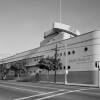Lost LA Field Notes: Fantasyland

Union Bank is a proud sponsor of Lost LA. 
Why couldn’t Disneyland have happened anywhere but Southern California? There’s a short answer: the film industry, headquartered here, spawned Anaheim’s Magic Kingdom. But the longer, more interesting answer, which we explore in this “Fantasyland” episode of “Lost LA,” looks to L.A.’s long tradition of creating imaginatively-themed environments. Had we not been limited to 30 minutes, we could have easily started the episode with the region’s romantic rediscovery of its mission ruins in the late-19th-century, or explored the fantasy worlds of Clifford Clinton, or examined Christine Sterling’s reinvention of a Chinatown alleyway as the Spanish fantasy we know as Olvera Street.
As it is, our episode traces a story that includes Babylon film sets, silent-era studio tours and theme restaurants. And it follows the thread to the present day, when our region’s most successful shopping malls — places like real estate developer Rick Caruso’s Grove and Americana — succeed in part because their design skillfully transports visitors someplace or somewhere else.
Meeting an Imagineer

Throughout my college years, I worked as a ride operator at Disneyland. I dispatched boats on Pirates of the Caribbean, paddled 22-seater canoes around Tom Sawyer’s Island and collected FastPass tickets at Splash Mountain. For a time, too, I drove motor vehicles down Main Street, U.S.A.: the double-decker Omnibus, the tiny red and yellow motorcars and the replica fire engine that became a favorite of Walt Disney.
It was a treat, then, to meet Bob Gurr, the man who designed these Main Street vehicles. (The red and yellow cars are, in fact, nicknamed “Gurrmobiles.”) In the episode, the retired Imagineer tells me how he designed the inside of the vehicles with modern stock parts to keep them reliable and efficient, all while designing the outside of each vehicle to contribute to Main Street’s turn-of-the-century theme. The cars are still on the road today, six decades later.
The Tam O’Shanter
Originally, we hoped to weave the story of Los Angeles’ themed restaurants — imaginatively designed eateries like Clifton’s (which just this week discontinued food service while maintaining the building as a nightclub) and Don the Beachcomber — into this episode. In fact, we shot an entire sequence on the Tam O’Shanter.
This Scottish-style pub on Los Feliz Boulevard transcends mere theming. Its decor deftly incorporates story elements from the eponymous narrative poem by Robert Burns about a drunken farmer at the local pub. Pay attention to the details, and next time you cut into your prime rib, you might be able to imagine farmer Tam in the next booth over with his drunken friends, as a storm rages outside:
"The night drave on wi' sangs and clatter;
And ay the ale was growing better:
The landlady and Tam grew gracious
Wi' secret favours, sweet, and precious:
The souter tauld his queerest stories;
The landlord's laugh was ready chorus:
The storm without might rair and rustle,
Tam did na mind the storm a whistle."
Unfortunately, our interview with Richard Frank, president and CEO of Lawry’s Restaurants, didn’t make the final cut. We plan to release the interview as an exclusive online video.
Essential Reading
- “The Disneyland Story: The Unofficial Guide to the Evolution of Walt Disney’s Dream” by Sam Gennawey (Unofficial Guides, 2013)
- “Designing Disney’s Theme Parks: The Architecture of Reassurance,” edited by Karal Ann Marling (Flammarion, 1997)
- “Walt Disney’s Disneyland” by Chris Nichols (Taschen, 2018). I haven’t yet gotten my hands on this book — it’s apparently on perpetual backorder — but given the author’s passion for Southern California’s material history, this is sure to be a must-read

The Archives
Both the Walt Disney Archives and NBCUniversal Archives, like other corporate archives, primarily serve their respective companies’ ongoing operations and are not usually open to outsiders. So it was a huge privilege to visit both in the making of this episode.

At Disney, I spoke to Rebecca Cline about the origins of Disneyland and saw a hand-drawn sketch that helped sell investors on the concept. (In the episode, look closely at Rebecca’s white archivist gloves.)
At NBCUniversal, Jeff Pirtle showed me a series of photographs of Universal’s original studio tour, which opened in 1915. According to studio lore, these photos inspired MCA chief Lew Wasserman to reopen Universal’s studios to the public. Apocryphal or not, it’s a wonderful story that speaks to the enduring value of archival collections.
I was also delighted to visit author and historian Marc Wanamaker at his office on the historic Raleigh Studios lot. Marc’s Bison Archives are accessible by appointment only. But you’ll want to get in touch with him regardless. His encyclopedic knowledge of early Hollywood history is just as invaluable a resource as the collections he maintains.
Top Image: In conversation with original Imagineer Bob Gurr | Katie Noonan
















